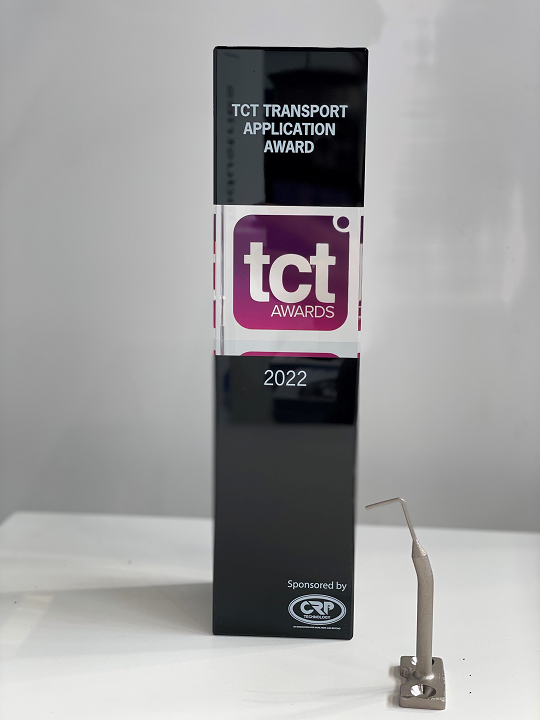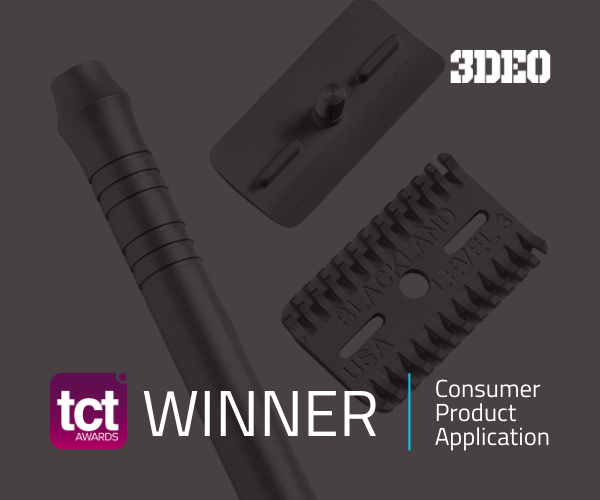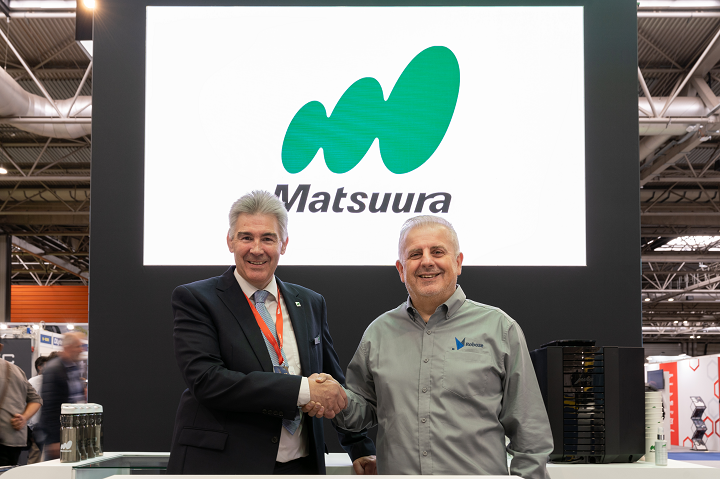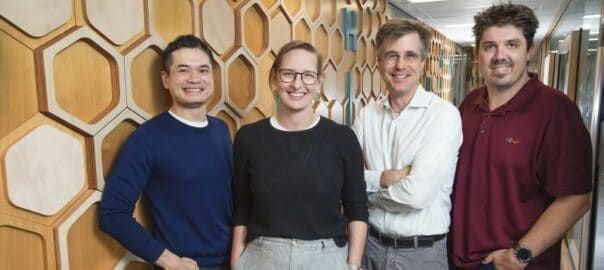We’re starting off with some awards news in today’s 3D Printing News Briefs, as Additive Industries and 3DEO both won big at the TCT Awards. Also at TCT 3Sixty, Roboze finalized an agreement with Matsuura Machinery Ltd. Then, we’ll move on to standards, as ASTM International is working on a new one that will help with the use of powder bed fusion technology in medical device manufacturing. Speaking of the medical sector, Sanwa is bringing 3D printing to the field of dentistry in Japan. Finally, researchers in Australia are using intersecting light beams to control chemical reactions in a next-gen 3D printer.
Additive Industries Win TCT Transport Application Award
At the recent TCT Awards, Dutch metal 3D printer manufacturer Additive Industries won the TCT Transport Application Award for its work on a tooling nozzle for the Volkswagen Tiguan, in addition to being a finalist for the TCT Hardware Award – Non-polymer systems. Working with Additive Industries, Volkswagen achieved a 650% cost reduction in fabricating the nozzle, which was used for automated deposition of a rope in the vehicle’s chassis flange. The automaker used the MetalFAB metal 3D printer to manufacture the nozzle in a single piece, rather than two, out of 316L stainless steel – a cheaper option than its original titanium alloy.
Also at the TCT Awards, which are produced by The TCT Group in conjunction with the TCT 3Sixty additive manufacturing event in Birmingham, high-volume metal 3D printing company 3DEO won the TCT Consumer Product Application Award. The company, which launched its new Saffron platform and patented Intelligent Layering technology earlier this year, won for a 3D printed production razor it manufactured for Blackland Razors. The double-edged safety razor, called the Era, was 3D printed out of stainless steel, and is fully customizable.
Roboze & Matsuura Machinery Finalize Agreement
The awards aren’t all that happened at the recent TCT 3Sixty. At the show, Roboze announced that it had finalized an agreement with Matsuura Machinery Ltd to be its representative in the UK. Matsuura offers OEMs, subcontractors, and SMEs with fully engineered manufacturing processes, like automated multi-axes CNC machining solutions and metal and plastic 3D printers. Now, Matsuura has increased its 3D printer portfolio by adding the large-format ARGO 500 by Roboze, its industrial super polymer system. The printer will be on display in Matsuura’s show room in Coalville.
“Roboze 3D printing technology has demonstrated its ability to transform manufacturing and be a valuable asset in the armoury of progressive manufacturing companies. Adding Roboze to our portfolio line-up makes us a formidable player in the additive manufacturing supply chain in the UK, offering class leading technology, creating components from a myriad of materials,” said Roger Howkins, Managing Director of Matsuura Machinery Ltd. “We look forward to customers seeing the Roboze product range installed and demonstrating their prowess at our brand-new Additive Manufacturing Centre in Leicestershire in the near future.”
New PBF Standard Guiding Medical Device Manufacturers
ASTM International has a new standard, developed by its additive manufacturing F42 committee, which will offer guidance to medical device manufacturers about reusing powder in powder bed fusion AM processes. The new F3456 standard explains what ASTM refers to as the “seven broad reuse schema” that will offer manufacturers pertinent information for regulatory bodies that want a better understanding of how powder reuse schemes can affect the performance of medical devices. This is the actually the first standard developed by the F42 subcommittee on medical and biological standards.
“Additive manufacturing manufacturers of medical devices and regulatory bodies will find this new guide to be useful. The guide may also be useful to AM manufacturers to generally describe their reuse process to customers without having to give away specific manufacturing process information,” said ASTM International member Matthew Di Prima.
Japanese Sanwa Dental Adopting AM Technology
Tokyo-based Sanwa Dental is bringing 3D printing to dentistry in Japan, as it’s announced the successful adoption of additive manufacturing in its Thailand dental laboratory. Sanwa believes that if the Japanese dental industry witnesses more widespread adoption of the technology, more patients would have easier access to high-quality dentures, implants, and other dental applications, so it’s leading the way in expanding the use of the technology in the region. The new printer Sanwa has installed was supplied by manufacturer Profeta, which is based in Nanjing Zijin, China and specializes in metal 3D printers for dental laboratories.
Sanwa explained some of the many benefits of additive manufacturing, including creating designs that would be nearly impossible with normal casting methods. One example was designing and printing dentures with thinner, smaller metal frames, so that the wearer can speak more easily and clearly. Another benefit was reducing the number of steps in creating these titanium denture frames from ten to just five steps, which resulted in an increase in productivity.
QUT Publishes Research on Next-Gen 3D Printers
A team of researchers from Queensland University of Technology (QUT) in Australia published a paper on their work using intersecting light beams to control chemical reactions in an advanced material that can 3D print entire layers, rather than single points at a time. According to Dr. Sarah Walden from the QUT Centre for Materials Science interdisciplinary research team, the precision that light offers in starting a reaction makes it a great tool for activating chemical processes. She explained that in this case, two differently colored light beams are used, causing a reaction only where the two intersect, and ARC Laureate Fellow Professor Christopher Barner-Kowollik noted that two such color-activated materials are very rare. He said that the team’s research was about proving how viable the ink is for the next generation of 3D printers.
“We use one colour of light to activate one molecule, and the second colour of light to activate another molecule. And where the two light beams meet, the two activated molecules react to form a solid material,” Dr. Walden explained. “Normally, in a 3D printer, the inkjet moves around in two dimensions, slowly printing one 2D layer before moving up to print another layer on top. But using this technology, you could have a whole two-dimensional sheet activated, and print the entire sheet at once.”
Subscribe to Our Email Newsletter
Stay up-to-date on all the latest news from the 3D printing industry and receive information and offers from third party vendors.
Print Services
Upload your 3D Models and get them printed quickly and efficiently.
You May Also Like
The Market and Industry Potential of Multi-Material 3D and 4D Printing in Additive Electronics
Additive manufacturing leverages computer-based software to create components for products by depositing either dielectric or conductive materials, layer by layer, into different geometric shapes. Since its birth in the 1980s,...
3DPOD 262: Bio-inspired Design for AM with Dhruv Bhate, Arizona State University
Dhruv Bhate is an associate professor at Arizona State University. There, he looks at structures, materials, and design. Previously, he worked at PADT as well as in the semiconductor and...
3DPOD 261: Tooling and Cooling for AM with Jason Murphy, NXC MFG
Jason Murphy´s NXC MFG (Next Chapter Manufacturing) is not a generalist service; instead, the company specializes in making tooling. Using LPBF and binder jet, the company produces some of the...
3DPOD 260: John Hart on VulcanForms, MIT, Desktop Metal and More
John Hart is a Professor at MIT; he´s also the director of the Laboratory for Manufacturing and Productivity as well as the director of the Center for Advanced Production Technologies....






































